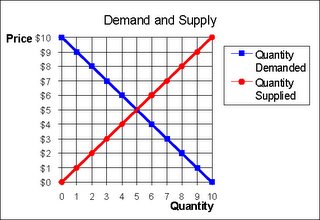Premier Beattie is a dumbass
The Premier of Queensland recently gave us the following stupidity:
QUEENSLAND Premier Peter Beattie has threatened to name and shame anyone caught profiteering in areas devastated by Cyclone Larry. Consumer affairs officers have begun investigating a string of complaints of shops and services raising prices for goods in cyclone-ravaged parts of far north Queensland.Watch out evil "profiteers" ! Premier Beattie is on the loose. Hopefully someone can knock some sense into him with a clue-by-four. I ask, what is the problem with profiteering exactly ? Well in America, they call it "price-gouging", and they have laws against it. I have already explained why they are a total sham in an earlier post, but I will gladly add more arguments against the outlawing or public shaming of people who raise the price of items in demand during disasters/shortages.
The basic story is that if merchants normally sell some random useful item, like petrol or chocolate or electricity generators, there is a price which is determined by supply and demand meeting, as shown in the graph below. During a cyclone, the demand for electricity generators goes up probably 50-fold, which would see the blue demand curve below jump out to the right/upwards. Under a free market, the supply and demand would meet at a much higher price and quantity. But the supply curve will not move.
Now if you look at the consumer/producer surplus graph, you can see that in a free market, consumers AND producers both profit as represented by the blue and yellow regions respectively.


Now here is the basic first-year economics theory. This is fairly intuitive. The blue demand curve represents the quantity of units all the consumers in the market would be willing to purchase at a particular price. The red supply curve represents the output in terms of "electric generators sold" of all the producers out there, and it shows how many units the producers would be willing to sell at a given price.
Where these two curves meet, determines the market price and market quantity.
The blue region exists because there are a whole lot of consumers who were more than happy to buy the item at the market price. Some of them are willing to pay even more than that. So the blue region is the "consumer surplus" or profit to consumers. The yellow region exists because there are a whole lot of producers who were more than happy to sell (supply) that number of units at the market price. In fact some producers were willing to sell even below the market price, so the profit to producers is the yellow region.
This is why profits are not necessarily a bad one-sided phenomena. Both parties gain from the transaction. But.. getting back to the original story, Peter Beattie wants to humiliate any producers with the common sense of adjusting their price upwards when demand for their items skyrockets. This means that there will be a huge shortage. In the graph above, producers cannot charge more than the existing market price ($5) even though there would now be 50-times as many people will to buy it at that price (250 people). Producers are only willing to sell 5 units at this price.. so 245 people lose out.
If price could adjust to lets say, $50 or $100, then the consumers who really value the item in the wake of an emergency can fork out in the short term and pay more. Otherwise, if they wait for the situation to recover, supplies will get through, the emergency will slowly dissipate, demand will drop back down, as will prices.
So to summarise, Peter Beattie wants to shame and humiliate the producers who sell items in massive demand during an emergency, if they allow prices to adjust to what a free market would generate.



|